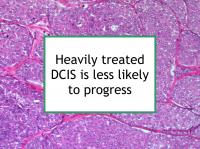Ductal carcinoma in situ (DCIS) is associated with increased risk of invasive breast cancer. DCIS is classified as non-invasive because the cancer cells are confined to milk ducts and have not spread beyond the duct walls to invade the surrounding tissue. Significant risk of relapse or progression remains for many years after treatment for DCIS.
Now a new study has reported that DCIS that is heavily treated with either mastectomy or breast conserving surgery plus radiotherapy and tamoxifen has the best long-term outcomes.
Predictors of progression of DCIS to invasive breast cancer
Researchers are making progress in developing methods (including multigene and antibody signature tests) to predict likelihood of relapse or progression of DCIS. In the mean time, the following factors have been found to be associated with increased risk of recurrence of DCIS or progression to invasive breast cancer:
- Failure to follow lumpectomy to remove DCIS lesion with radiotherapy (even if the DCIS is low grade)
- DCIS tumor size > 2 cm
- Palpable DCIS (lumps or thickening that can be felt by hand)
- Close or positive surgical margins or large number of involved ducts at the nearest margin
- Dense breasts (high percent mammographic density)
- Young age (under 45 years)
- DCIS with microinvasion
- Comedo necrosis
- HER2 overexpression (HER2+)
- High proliferation index (Ki-67)
- Concurrent LCIS (lobular carcinoma in situ) and DCIS.
Recurrence is lower when DCIS is heavily treated
The meta-analysis of previous studies referenced at the beginning of this news story was designed to determine the long-term recurrence and breast cancer-specific death rates of women with DCIS, according to type of treatment. To conduct the study, the authors used data from five prospective and twenty-one retrospective studies of women with pure DCIS with a median or average follow-up period of at least 10 years. The study included a total of 9,404 DCIS cases in 9,391 women.
The adjusted long-term local (in the same breast that was treated) DCIS recurrence rate was 2.6% for women who underwent mastectomy, 13.6% for those treated with lumpectomy or other breast-conserving surgery plus radiation, 25.5% for breast-conserving surgery without radiation, and 27.8% for women who only underwent a biopsy (who presumably had low-grade disease and were left with residual DCIS in their breasts).
Treatment with tamoxifen improved these results. The local recurrence rate was 9.7% for breast-conserving surgery plus radiation and tamoxifen, and 24.7% for breast-conserving surgery plus tamoxifen without radiation.
Breast-conserving surgery plus radiation and tamoxifen was found to result in significantly lower progression to invasive breast cancer in the treated breast. Compared to treatment with breast-conserving surgery plus raditation plus tamoxifen, women who underwent breast-conserving surgery alone had 2.6 times the rate of invasive relapse, those who underwent breast-conserving surgery plus tamoxifen had 2.5 times the rate, and those who underwent breast-conserving surgery plus radiotherapy had 1.6 times the rate.
The 10-year breast cancer-specific death rate was similar for mastectomy and breast-conserving surgery with or without radiotherapy (1.3% to 2.0%), and only slightly higher for biopsy-only (2.7%) (an increase that was not statistically significant). However, when 15-year data (where available) was analyzed, the biopsy-only group was found to have a local DCIS recurrence rate of 40.2%. This group also experienced progression to invasive breast cancer in the originaly biopsied breast 28.1% of the time, and a breast cancer-specific death rate of 17.9%. Also among the 15-year data group, the breast cancer-specific death rate was 55.2% for those who experienced local progression to invasive breast cancer.
The authors conclude that more local intervention was associated with reduced local relapse for women with DCIS at long-term follow-up. Women who underwent breast conserving treatment experienced less progression to invasive breast cancer if they received both tamoxifen and radiotherapy rather than just one of these treatments.
Please see our article on DCIS prognosis for more information.
